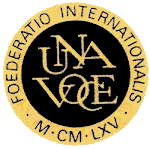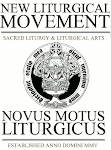Standing
§. Stand up straight; not stooped.
§. Walk gracefully, reverently and erect.
§. Never walk backwards, particularly when descending the altar steps.
§. Do not turn your back unnecessarily to the Blessed Sacrament or the altar.
Kneeling
§. Kneel upright. You should not normally bow when you are kneeling, except during Confiteor and Misereatur tibi.
Hands
§. Keep your hands joined on your breast, either with the palms laid against each other with your fingers extended and your thumbs crossed one over the other, or with your fingers clasped together. The first way is the better.
§. When you are holding something in one hand, the other should be laid flat on your breast.
§. When you hand anything to the Celebrant, it is proper always to use the right hand to give it to him. When you are handing the cruets to the Celebrant, you use your right hand, when you take the cruets back, use your left hand.
Genuflections
Bows
There are two types of bow: Simple and Deep.
§. A simple bow is more than a mere nod, and is made by bowing the head.
§. To make a deep bow bend your head and shoulders. Do not, however, bow from the waist.
PREPARATION
§. Place the altar cards on the altar: the largest one in the centre, the Last Gospel card onthe left-hand side of the altar (as you look at the altar from the front); the Gospel side, and the card with Lavabo on it on the right-hand side; the Epistle side. Set the Missal-stand on the altar at the Epistle corner parallel with the front of the altar. Light two candles on the altar.
§. There should be one server only for Low Mass.²
§. Assist the Celebrant to vest.
THE STAR OF MASS
Take the Missal in with you and place it on the Missal stand with the spine to the left.³
Carry the closed Missal by placing the base of the spine in the crook of your left arm, and supporting it with your right hand.This enables you to release your right hand from theMissal to give the Celebrant holy water at the sacristy door, and to use your right hand to take the Celebrant's biretta when you reach the foot of the altar. If you were to grasp the Missal with two hands, you would have difficulty in easily performing these actions.
Give the Celebrant holy water by dipping your fingers into the holy water stoup and offering them to the Celebrant for him to take some of the water from your fingers. Make the sign of the cross on yourself.
On arrival at the altar, before the step, genuflect,⁴on the Celebrant's right, then receive the biretta from the him. You should kiss first the Celebrant's hand then the biretta when you receive it. When you give the biretta to the Celebrant, either at the end of Mass, or if he goes to the pulpit to preach during Mass, kiss first the biretta, then, as you give it to him, his hand.⁵
Put the biretta on the altar step for the moment, and ascend to the footpace of the altar. Place the unopened⁶ Missal on the stand, the spine towards the centre of the altar.
Descend by way of the side steps, coming down to the Epistle side in plano, and walk around to the front of the altar, pick up the biretta and place it on the credence table or the sedilia or other convenient place.
Cross before the altar, genuflecting at the middle, and await the Celebrant on the Gospel side. When the Celebrant joins you, kneel on the floor of the sanctuary as he genuflects or bows.
Preparatory Prayers
Introit to Gradual
§. Make the sign of the cross with the Celebrant at the start of the Introit.
§. Make the responses to Kyrie eleison, and say Amen after the Collect.
§. At the end of the Epistle say Deo gratias. Then rise, go to the centre and genuflect, then go round to the Epistle corner of the altar.
§. Go round in plano and stand at the foot of the steps. Wait at the Epistle corner during the Gradual or Tract.⁹
Gospel
When the Celebrant goes to the centre, take the Missal on its stand, bow to the altar,¹o carry the Missal down to the floor in the middle, genuflect, and go direct, up to the altar on the Gospel side, Bow to the altar, and put the stand on the altar diagonally. Stand by the Missal. When the Celebrant comes to read the Gospel, answer the versicles at the beginning and make the sign of the cross with your thumb on your forehead, lips, and breast with the Celebrant. If the Holy Name occurs in the opening words of the Gospel, bow your head. Bow to the altar, and go down to the floor, and walk round to the Epistle side in plano, genuflecting at the centre as you pass before the altar,¹¹ and stand facing towards the place of the Gospel while it is read. If the Celebrant genuflects during the Gospel, genuflect also. At the end answer Laus tibi Christe. Kneel down.¹²
When the Celebrant has said Dóminus vobiscum and Orémus at the Offertory, go to the centre, genuflect to the altar and go to the credence table. Take the cruets, the wine cruet in your right hand, the water in your left. Stand at the end of the altar. When the Celebrant comes to you, bow to him and hand him the wine cruet ¹³ with your right hand, transfer the water cruet to that hand, and receive the wine cruet back with your left hand. Hold the water cruet towards the Celebrant for him to bless the water, then hand it to him with your right hand.
Bow to the altar, and return to the credence table. Put down the wine cruet there. Pick up the lavabo towel. The towel you may spread over your left arm, or lay it on the altar at the Epistle corner, preferably arranged in a small pyramid. With the water cruet in your right hand, take the lavabo bowl in your left. The Celebrant will come to wash his fingers. Bow to him. Hold the lavabo bowl under the Celebrant's hands and pour a little water from the cruet over his fingers. When he has dried his fingers, he will lay the towel over your left arm. Bow to him, and return to the credence table. Leave the cruet, bowl and towel on the credence. If the bell is on the table, take it with you. Go back to the middle before the altar, genuflect, then go to your place on the lowest step on the Epistle side, the side opposite the Missal.
When the Celebrant has said Orate fratres, wait until he has turned fully back to the altar, then respond Suscipiat Dóminus.... Respond to the versicles before the Preface. As the Celebrant said Sanctus, Sanctus, Sanctus, ring the bell three times.
THE CANON TO THE END OF MASS
When the Celebrant spreads his hands over the chalice at Hanc igitur, ring the bell once. Rise from your place, genuflect at the centre, and, taking the bell with you, ascend to the footpace and kneel there on the right of the Celebrant and a little behind him. At each Elevation, as the Celebrant elevates, raise the end of the chasuble with your left hand.¹⁴
Ring, the bell three times at each elevation.¹⁵ After the Elevations, return to the centre in plano, genuflect, and return to your place on the bottom step on the Epistle side. Strike ,your breast when the Celebrant does so at Agnus Dei. At Dómine non sum dignus, ring the bell once each time the Celebrant says these words.
After the Celebrant has received from the chalice, if you are to receive Holy Communion, go to the centre, genuflect to the altar, and go to the credence to collect the communion plate. Return to the centre, genuflect, and go and kneel on the footpace towards the Epistle side. When you receive the Host, hold the communion plate under your chin. Otherwise, if there are communicants, go to the credence table as above, and kneel at the side facing across the sanctuary until the Celebrant has said Ecce Agnus Dei... and Dómine non sum dignus...¹⁶ Then lead the Celebrant to the altar rails. As the Celebrant gives Holy Communion to each communicant, hold the communion plate under the communicant's chin. When all have received, hand the communion plate to the Celebrant. Kneel down where you are until the Celebrant has put away the Holy Eucharist. When he has done so rise, genuflect at the centre, and go to the credence table.
Ablutions
If only the Celebrant receives communion, go to the credence table as above, immediately. In either event, take the cruets and stand on the highest step below the footpace, holding the wine cruet in your right hand and the water cruet in your left. When the Celebrant holds the chalice towards you, draw near to him, bow to him, and pour wine into the chalice, the Celebrant will give you a sign when to stop. Bow again and return to where you were on the highest step. When the Celebrant has drunk the wine, he will come to where you are and rest the chalice on the altar, placing his fingers over it. With your right hand, pour a little wine over the Celebrant's fingers. Then pour water, the Celebrant will make a sign when enough has been poured. Bow to the Celebrant again, return to the credence table and put the cruets back there.
Go to the Gospel side, genuflecting at the centre as you pass. Take the Missal, on its stand, bow to the altar, carry the Missal down to the floor in the middle, genuflect, and go direct, up to the altar on the Epistle side, bow to the altar and place the Missal on its stand on the altar, square with the edge of the altar.¹⁷ Then go to kneel on the lowest step on the Gospel side, genuflecting, as always, when you pass the centre. Answer Amen at the end of the Postcommunion, Dóminus vobiscum, Ite missa est. (During the Easter Octave, the Celebrant will add two Alleluias to Ite missa est. Add them also to your response Deo gratias.) Make the sign of the cross at the blessing, answer Amen, then stand.
Last Gospel
The rule about always being on the side opposite the Missal no longer applies at this point. The Missal having been replaced by the Last Gospel card. Go to the centre, genuflect as you pass, and stand on the Epistle side at the place where you were kneeling previously. Face towards the place of the Gospel. Genuflect with the Celebrant at the verse Et Verbum caro factum est, and answer Deo gratias at the end of the Gospel.
On one day a year, it is possible there will be a special Last Gospel. On Palm Sunday, at a Mass which is not preceded by the Procession of Palms, the Celebrant will leave the Missal open when he goes to the centre after the Postcommunion. This is a sign that you must change the Missal over to the Gospel side. Precede as for the Gospel of the Mass. You may, if convenient, time your move so you are at the centre when the Celebrant gives the Blessing. In this case, kneel on the lowest step at the centre for the Blessing, then continue up to the altar to place the Missal there. Stay at the side to make the responses at the beginning of the Last Gospel. When you have made them, bow to the altar, and go to the Epistle side, genuflecting in the centre as always. Face towards the place of the Gospel (there is no genuflection during the Gospel).
At the end of the Last Gospel, wait for the Celebrant at the Epistle side. Take his maniple, an hand him the card for the Leonine Prayers. Kneel beside him on the lowest step during the prayers.
When the Celebrant ascends the steps to the altar to get the chalice, go to the altar also to bring the Missal away and get the biretta from the credence or wherever it is. You may find it more convenient to get the biretta earlier than this. Hand the biretta to the Celebrant with the solita oscula, genuflect when the Celebrant does so (or bows) and precede him to the sacristy. There bow to the sacristy crucifix with the Celebrant , bow to the Celebrant himself, lay down the Missal and assist the Celebrant to unvest.
Return to the sanctuary, extinguish the candles, and return the cruets to the sacristy.
Lastly, remove your cotta and cassock.
REQUIEM MASS
At Masses for the Dead omit the solita oscula. The psalm Iudica me is not said. If the Sequence Dies iræ is said, remain kneeling until the concluding verses before going to change the Missal. At the end of Mass, instead of Ite missa est the Celebrant says Requiescant in pace. To this answer Amen. The Blessing is not given.
------------§---§---§------------
¹ Or this may, be placed on the altar step next to where you will kneel on the Epistle side.
² A Low Mass with two servers is a very unsatisfactory practice. One of the servers is totally unnecessary, and unnecessary people should not be in the sanctuary. One of the two servers is surplus to requirements.
³ The rubrics of the Missal suppose that the server bring the Missal with him when the priest comes out to begin Mass, and that he take it back with him to the sacristy afterwards. Only at High Mass or Missa Cantata is it placed on the altar before Mass.
⁴Even if the Celebrant only bows.
⁵ These kisses are called in Latin solita oscula.
⁶ The server at a Low Mass never opens the Missal or turns its pages, the Celebrant does this himself.
⁷ This is the point when the Mass actually begins, and this is the server's (and the Celebrant's) entrance which is to be followed by the entry chant, the Introit.
⁸ But always kneeling on the opposite side to the Missal.
⁹If there is a Sequence, remain kneeling in your place until towards the last verse of this.
¹o The bow is usually made towards the crucifix, but is actually a salutation to the altar which represents the Body of Christ.
¹¹ When changing over the Missal, the server goes by the shortest route, direct from the altar, down the steps to the centre and after genuflecting there, direct up to the altar. Only when he is not carrying the Missal does he walk all the way round.
¹² The server kneels for the Creed - as strictly should the congregation at low Mass.
¹³ Do not kiss the cruets. As well as being inelegant, and unhygienic, a decree of the Sacred Congregation of Rites forbids the practice.
¹⁴Only as he elevates, not as he genuflects.
¹⁵ This is usually done by matching each ring to the action of the genuflections and the two Elevations.
¹⁶ Do not say the Confiteor before Holy Communion, rubric 503 of the 1962 Missal instructs: "Quoties sancta Communio infra Missam distributur, celebrans, sumpto sacratissimo Sanguine, omissis confessione et absolutione, dictis tamen Ecce Agnus Dei et ter Dómine, non sum dignus, immediate ad distribtionem sanctæ Eucharistiæ procedit" "Whenever Holy Communion is given within Mass, the Celebrant, having taken the most Sacred Blood, the confession and absolution being ommited, says Dómine non sum dignus thrice, and immediately distributes the Holy Eucharist."
¹⁷ Do not transfer the chalice veil from one side of the altar to the other. Not only is it unnessary, but it is easier for the Celebrant to pick the veil up from his right hand side rather from his left.









6 comments:
Do not kiss the cruets. As well as being inelegant, and unhygienic, a decree of the Sacred Congregation of Rites forbids the practice.
Which decree is this?
I have never understood why one is allowed to kiss the biretta but no the cruets? Surely both are either unhygienic or practically safe?
I have allways rung the bells at the consecration once at the genuflection,three times at the elevation once more at the genuflection for host and chalice.
when i used to serve mass as a young boy in the 50s and 60s the solita oscula never used to be carried out by servers in England and I still dont worry about it now,possibly some MCs would do it at Missa Cantata but not in my parish.
I don't keep the chapter and verse of the decrees of the Sacred Congregation of Rites at my fingertips but I know it exists because I've seen it.
Presumably the priest who taught me to serve in 1945 had also seen it because he told me not to kiss the cruets.
God bless,
Arthur.
Dear MC Man,
Ring the bells once for all the occasions there are.
God bless,
Arthur.
Post a Comment